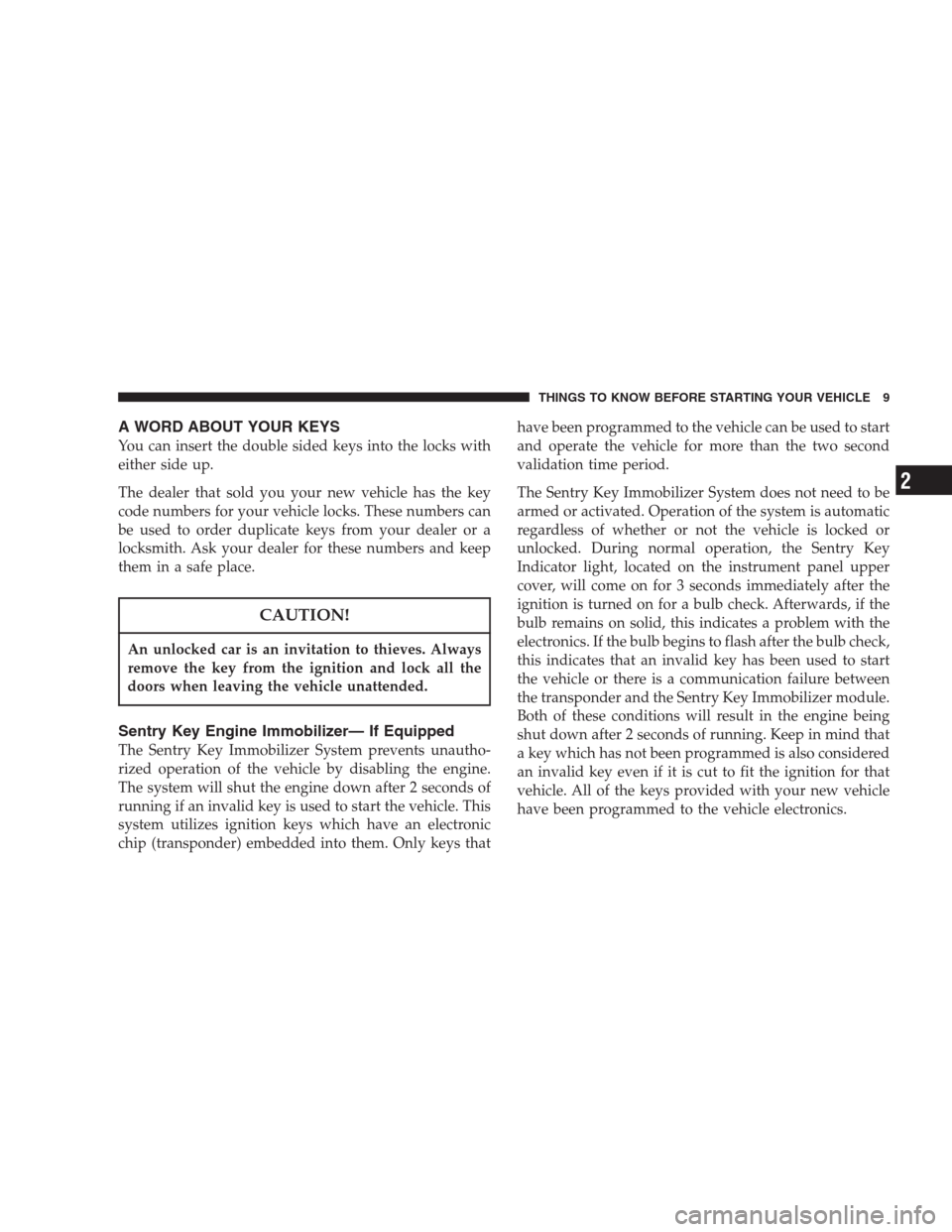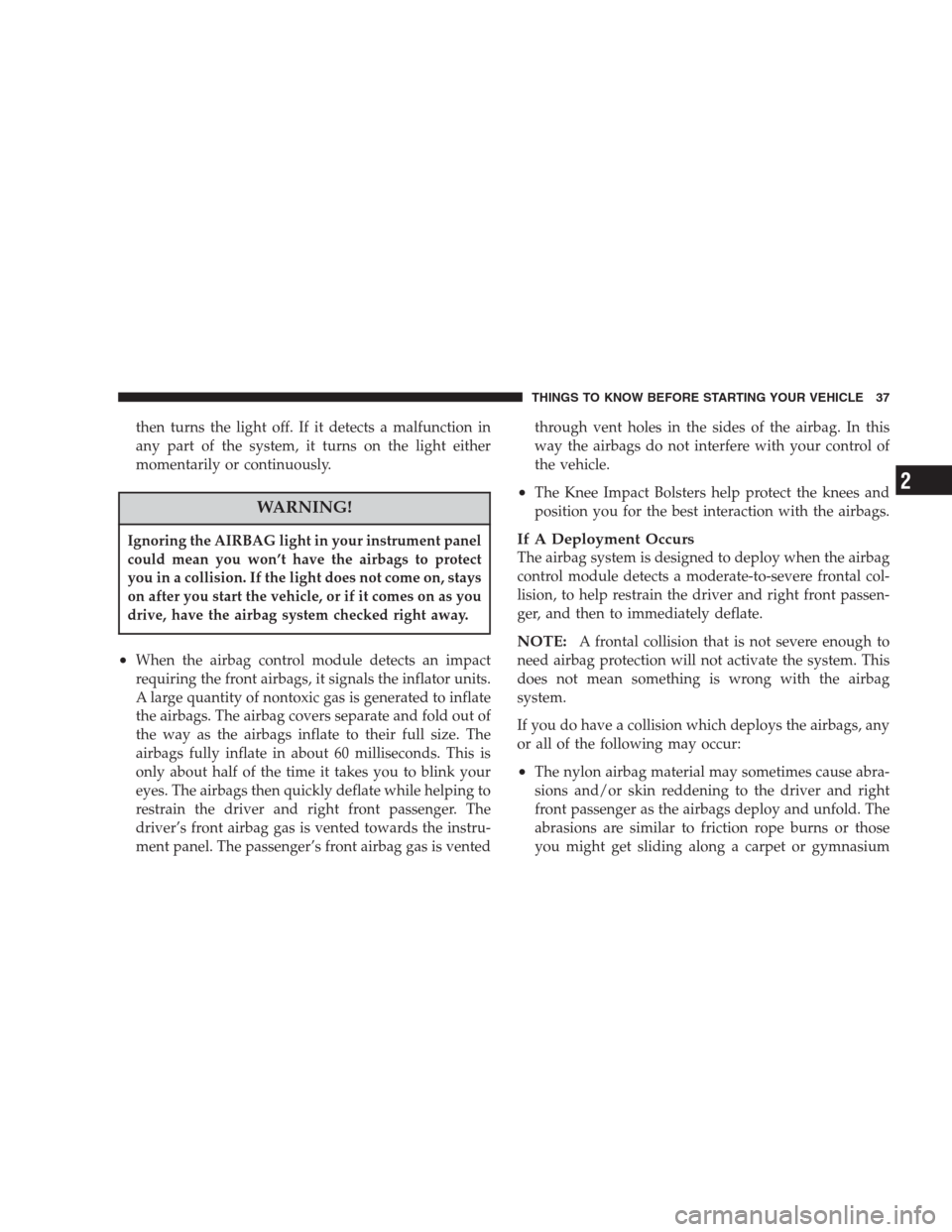instrument panel DODGE INTREPID 2004 2.G Owners Manual
[x] Cancel search | Manufacturer: DODGE, Model Year: 2004, Model line: INTREPID, Model: DODGE INTREPID 2004 2.GPages: 249, PDF Size: 4.87 MB
Page 1 of 249

TABLE OF CONTENTSSECTIONPAGE
1
INTRODUCTION.............................................................3
2
THINGS TO KNOW BEFORE STARTING YOUR VEHICLE...........................7
3
UNDERSTANDING THE FEATURES OF YOUR VEHICLE............................49
4
UNDERSTANDING YOUR INSTRUMENT PANEL..................................83
5
STARTING AND OPERATING................................................125
6
WHAT TO DO IN EMERGENCIES.............................................151
7
MAINTAINING YOUR VEHICLE..............................................165
8
MAINTENANCE SCHEDULES................................................211
9
IF YOU NEED CONSUMER ASSISTANCE.......................................227
10
INDEX...................................................................237
1
2
3
4
5
6
7
8
9
10
Page 6 of 249

WARNINGS AND CAUTIONS
This manual containsWARNINGSagainst operating
procedures which could result in an accident or bodily
injury. It also containsCAUTIONSagainst procedures
which could result in damage to your vehicle. If you do
not read this entire manual you may miss important
information. Observe all Warnings and Cautions.
VEHICLE IDENTIFICATION NUMBER
The vehicle identification number (VIN) is on a stamped
plate at the left front corner of the instrument panel,
visible through the windshield. This number also ap-
pears on the Automobile Information Disclosure Label
affixed to a window on your vehicle. Save this label as a
convenient record of your vehicle identification number
and optional equipment.
6 INTRODUCTION
Page 9 of 249

A WORD ABOUT YOUR KEYS
You can insert the double sided keys into the locks with
either side up.
The dealer that sold you your new vehicle has the key
code numbers for your vehicle locks. These numbers can
be used to order duplicate keys from your dealer or a
locksmith. Ask your dealer for these numbers and keep
them in a safe place.
CAUTION!
An unlocked car is an invitation to thieves. Always
remove the key from the ignition and lock all the
doors when leaving the vehicle unattended.
Sentry Key Engine Immobilizer— If Equipped
The Sentry Key Immobilizer System prevents unautho-
rized operation of the vehicle by disabling the engine.
The system will shut the engine down after 2 seconds of
running if an invalid key is used to start the vehicle. This
system utilizes ignition keys which have an electronic
chip (transponder) embedded into them. Only keys thathave been programmed to the vehicle can be used to start
and operate the vehicle for more than the two second
validation time period.
The Sentry Key Immobilizer System does not need to be
armed or activated. Operation of the system is automatic
regardless of whether or not the vehicle is locked or
unlocked. During normal operation, the Sentry Key
Indicator light, located on the instrument panel upper
cover, will come on for 3 seconds immediately after the
ignition is turned on for a bulb check. Afterwards, if the
bulb remains on solid, this indicates a problem with the
electronics. If the bulb begins to flash after the bulb check,
this indicates that an invalid key has been used to start
the vehicle or there is a communication failure between
the transponder and the Sentry Key Immobilizer module.
Both of these conditions will result in the engine being
shut down after 2 seconds of running. Keep in mind that
a key which has not been programmed is also considered
an invalid key even if it is cut to fit the ignition for that
vehicle. All of the keys provided with your new vehicle
have been programmed to the vehicle electronics.
THINGS TO KNOW BEFORE STARTING YOUR VEHICLE 9
2
Page 10 of 249

If the Sentry Key Immobilizer System indicator light
comes on during normal vehicle operation (it has been
running for longer than 10 seconds) a fault has been
detected in the electronics and the vehicle should be
serviced as soon as possible.
NOTE:
•
The Sentry Immobilizer System is not compatible with
remote starting systems. Use of these systems may
result in vehicle starting problems and loss of security
protection.
•Mobil SpeedPass, additonal sentry keys, or any other
transponder equipped components on the same key-
chain willnot
cause a key-related (transponder)
fault unless the additional part isphysically held
against the ignition keybeing used when starting
the vehicle. Cell phones, pagers, or other RF Elec-
tronics will also not cause interference with this
system.
The Theft Alarm Light, located on top of the instrument
panel, will illuminate for about 3 seconds when the
ignition switch is first turned to the On position. If the
vehicle electronics do not receive a valid signal from theignition key, the theft alarm light will flash continuously
to signal that the vehicle has been immobilized. If the
Theft Alarm Light remains On during vehicle operation,
it indicates a fault in the system electronics.
All of the keys provided with your new vehicle have
been programmed to the vehicle electronics.
Important Note about Service
A four digit PIN is needed to service the Sentry Key
Immobilizer System. This number can be obtained by the
dealership. However, this number can also be found on
your customer invoice that you were given upon receipt
of your vehicle. YOU MUST BRING ALL SENTRY KEYS
that are programmed to your vehicle directly to your
dealership for service.
Replacement Keys
NOTE:
Only keys that have been programmed to the
vehicle electronics can be used to start the vehicle. Once
a Sentry Key has been programmed to a vehicle, it can
not be programmed to any other vehicle.
10 THINGS TO KNOW BEFORE STARTING YOUR VEHICLE
Page 24 of 249

3. The SET light on the top of the instrument panel will
flash rapidly for 16 seconds. This shows that the system
is arming. If the light comes on but does not flash, the
system is still armed, but there is a problem in the trunk
circuit. After 16 seconds the SET light will continue to
flash slowly. This shows that the system is fully armed.
To disarm the system:
Unlock a front door using either the key or the Keyless
Entry Transmitter.
Tamper Alert
If the horn sounds 3 times when you unlock a front door
using either a key or the Keyless Entry Transmitter, the
alarm had been triggered. Check the vehicle for tamper-
ing.
Security System Manual Override
The system will not arm if you lock the doors using the
manual lock control.
24 THINGS TO KNOW BEFORE STARTING YOUR VEHICLE
Page 25 of 249

POWER WINDOWS
Window controls on the driver’s door control all door
windows.
The driver’s window switch has an Auto Down feature.
Press the window switch past the detent, release, and the
window will go down automatically. Press the switch a
second time in either direction to stop the window.
To open the window part way, press the window switch
to the detent and release it when you want the window to
stop.The window lock switch on the driver’s door allows you
to disable the window control on the other doors.
REMOTE TRUNK LID RELEASE
You can open the trunk lid from inside the vehicle by
pressing the switch on the left side of the instrument
panel. The transmission must be in Park before the
switch will operate.
THINGS TO KNOW BEFORE STARTING YOUR VEHICLE 25
2
Page 33 of 249

Driver and Right Front Passenger Supplemental
Restraint System (SRS) - Airbag
This vehicle has front airbags for both the driver and
front passenger as a supplement to the seat belt restraint
systems. The driver’s front airbag is mounted in the
center of the steering wheel. The passenger’s front airbag
is mounted in the instrument panel, above the glove
compartment. The words SRS AIRBAG are embossed on
the airbag covers.If the vehicle is equipped with side airbags, they are
located inside the driver and front passenger seats, and
their covers are also labeled SRS AIRBAG.
THINGS TO KNOW BEFORE STARTING YOUR VEHICLE 33
2
Page 35 of 249

be secured in the rear seat in child restraints or belt-
positioning booster seats appropriate for the size and age
of the child.
Older children who do not use child restraints or belt-
positioning booster seats should ride properly buckled
up in the rear seat. Never allow children to slide the
shoulder belt behind them or under their arm.
If a child from 1 to 12 years old must ride in the front
passenger seat because the vehicle is crowded, move the
seat as far back as possible, and use the proper child
restraint. See the section on “Child Restraint”.
You should read the instructions provided with your
child restraint to make sure that you are using it properly.
2. All occupants should wear their lap and shoulder belts
properly.
3. The driver and front passenger seats should be moved
back as far as practical to allow the front airbags room to
inflate.4. If your vehicle has side airbags, do not lean against the
door, airbags will inflate forcefully into the space be-
tween you and the door.
WARNING!
•Relying on the airbags alone could lead to more
severe injuries in a collision. The airbags work
with your seat belt to restrain you properly. In
some collisions the airbags won’t deploy at all.
Always wear your seat belts even though you
have airbags.
•Being too close to the steering wheel or instru-
ment panel during airbag deployment could cause
serious injury.
•Airbags need room to inflate. Sit back, comfort-
ably extending your arms to reach the steering
wheel or instrument panel.
•If the vehicle has side airbags, they also need
room to inflate. Do not lean against the door. Sit
upright in the center of the seat.
THINGS TO KNOW BEFORE STARTING YOUR VEHICLE 35
2
Page 36 of 249

Airbag System Components
The airbag system consists of the following:
•ACM (Airbag Control Module)
•AIRBAG Readiness Light
•Driver and Passenger Front Airbags
•Optional Driver and Passenger Side Airbags.
•Steering Wheel and Column
•Instrument Panel
•Interconnecting Wiring
•Crash Sensors
•Knee Impact Bolsters
The side airbag system, on vehicles so equipped, consists
of the following:
•AIRBAG Readiness Light
•Side Airbag in the Driver’s Seat
•Side Airbag in the Passenger’s Seat
•ACM (Airbag Control Module)
•SIACM (Side Impact Airbag Control Module)
•Interconnecting Wiring
How the Frontal Airbag System Works
•
The front airbag control module determines if a frontal
collision is severe enough to require the airbags to
inflate.
•The airbag control module will not detect side, roll
over, or rear collisions.
•The airbag control module also monitors the readiness
of the electronic parts of the system whenever the
ignition switch is in the START or RUN positions.
These include all of the items listed above except the
knee bolsters, the instrument panel, and the steering
wheel and column. If the key is in the OFF position, in
the ACC position, or not in the ignition, the airbags are
not on and will not inflate.
•The airbag control module also turns on the
AIRBAG light in the instrument panel for 6 to
8 seconds when the ignition is first turned on,
36 THINGS TO KNOW BEFORE STARTING YOUR VEHICLE
Page 37 of 249

then turns the light off. If it detects a malfunction in
any part of the system, it turns on the light either
momentarily or continuously.
WARNING!
Ignoring the AIRBAG light in your instrument panel
could mean you won’t have the airbags to protect
you in a collision. If the light does not come on, stays
on after you start the vehicle, or if it comes on as you
drive, have the airbag system checked right away.
•When the airbag control module detects an impact
requiring the front airbags, it signals the inflator units.
A large quantity of nontoxic gas is generated to inflate
the airbags. The airbag covers separate and fold out of
the way as the airbags inflate to their full size. The
airbags fully inflate in about 60 milliseconds. This is
only about half of the time it takes you to blink your
eyes. The airbags then quickly deflate while helping to
restrain the driver and right front passenger. The
driver’s front airbag gas is vented towards the instru-
ment panel. The passenger’s front airbag gas is ventedthrough vent holes in the sides of the airbag. In this
way the airbags do not interfere with your control of
the vehicle.
•The Knee Impact Bolsters help protect the knees and
position you for the best interaction with the airbags.
If A Deployment Occurs
The airbag system is designed to deploy when the airbag
control module detects a moderate-to-severe frontal col-
lision, to help restrain the driver and right front passen-
ger, and then to immediately deflate.
NOTE:A frontal collision that is not severe enough to
need airbag protection will not activate the system. This
does not mean something is wrong with the airbag
system.
If you do have a collision which deploys the airbags, any
or all of the following may occur:
•The nylon airbag material may sometimes cause abra-
sions and/or skin reddening to the driver and right
front passenger as the airbags deploy and unfold. The
abrasions are similar to friction rope burns or those
you might get sliding along a carpet or gymnasium
THINGS TO KNOW BEFORE STARTING YOUR VEHICLE 37
2